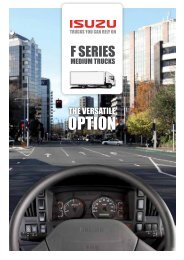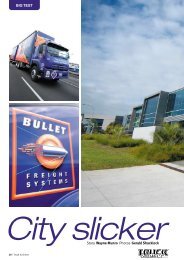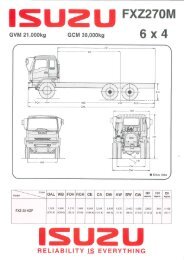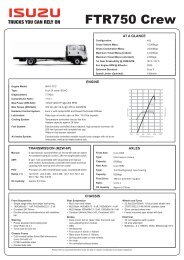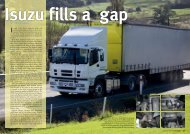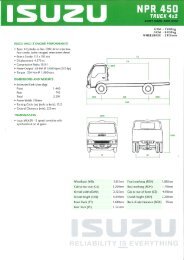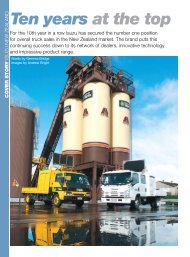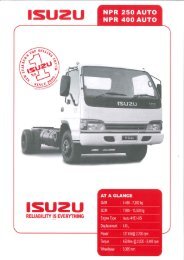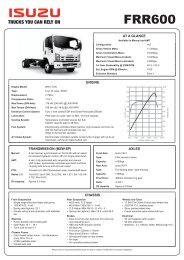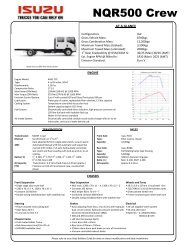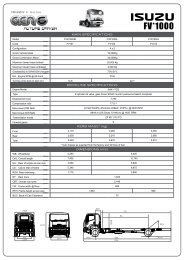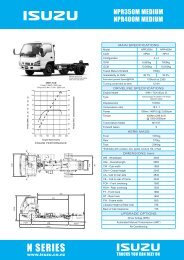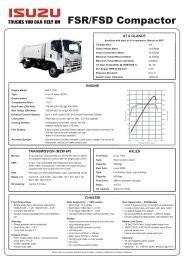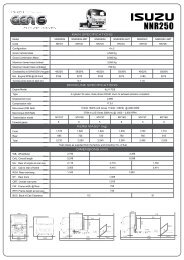Burning need for - Isuzu
Burning need for - Isuzu
Burning need for - Isuzu
You also want an ePaper? Increase the reach of your titles
YUMPU automatically turns print PDFs into web optimized ePapers that Google loves.
The <strong>Isuzu</strong> excels on narrow<br />
farm tracks.<br />
A bull-bar is a handy<br />
addition, along with ferry<br />
tie-downs that double as<br />
towing eyes.<br />
have to suffer the embarrassment of being overtaken<br />
on their way to an emergency. The drivers<br />
are not allowed to exceed the speed limit, even<br />
though they are all trained and certified to drive<br />
an emergency vehicle.<br />
Ian admits to a Henry Ford mentality that<br />
likes to keep things simple, and here the <strong>Isuzu</strong><br />
has several advantages. These include its proven,<br />
straight<strong>for</strong>ward vacuum-boosted, hydraulic<br />
brake system. Ian prefers this over air brakes<br />
which are a concern in a rural fire truck, especially<br />
if they lock on when a leak occurs. Ian<br />
explains that on the cross country terrain, an<br />
airline could be vulnerable to sticks and rocks. In<br />
the unlikely event that the truck <strong>need</strong>s to outrun<br />
a fire, it’s better to have no brakes than brakes<br />
that are locked on.<br />
Also <strong>for</strong> reliability reasons, the suspension is<br />
all steel leaf springs. Most road trucks go <strong>for</strong> the<br />
com<strong>for</strong>t and advantages of air, but Ian doesn’t<br />
want the risk of, say, a waratah post through an<br />
airbag in an emergency. Fire trucks can sit around<br />
between outings, but they <strong>need</strong> to be ready to go<br />
in an instant; the time taken to charge an empty<br />
air system could cost a life or a property.<br />
The trucks also have a battery saver system<br />
fitted, so that if someone leaves a light or radio<br />
on <strong>for</strong> a few days, the batteries will retain<br />
enough charge to start the truck. The volunteers<br />
also appreciate having a truck that can be rollstarted.<br />
One of the authority’s guidelines is that a<br />
truck should clock up a minimum of 30 kilometres<br />
a week. Ian says this means the trucks<br />
cover more distance on routine driving than<br />
emergency work, but they have fewer problems<br />
such as leaking seals which in turn reduces<br />
maintenance. Taking the truck <strong>for</strong> a spin makes<br />
the crews more familiar with the truck and their<br />
territory, too. Ian also ensures the trucks have at<br />
least 2000 kilometres on them be<strong>for</strong>e they are<br />
handed over. “We’ve found that having 2000<br />
kilometres is pretty critical, otherwise the engine<br />
just doesn’t bed in,” he says. Often the trucks do<br />
only about 2000 kilometres a year. “By not running<br />
the trucks enough we find a whole array<br />
of problems that a commercial operator would<br />
never encounter,” Ian adds.<br />
Ian is sometimes called overseas when more<br />
fire officers are <strong>need</strong>ed to fight a major bushfire,<br />
usually in Australia. The experience has given<br />
him good insights on rural fire truck concepts<br />
and keeps him up to speed with international<br />
developments, which can quickly be implemented<br />
locally. Other changes to the trucks make<br />
safety a priority: the centre seat has a lap and<br />
diagonal belt fitted, the top mount is an engineer-certified<br />
brace spaning the rear window of<br />
the cab, and a map reading light and a powerful<br />
handheld spot light are mounted on the dash.<br />
Underneath the front bumper, a guard protects<br />
the radiator and a bush bar is mounted<br />
above the bumper. One of the reasons <strong>for</strong> these<br />
additions is to protect the truck should it be necessary<br />
to drive through a fence. As Noel Percy<br />
explains, farm machinery occasionally starts a<br />
fire in a hay paddock during haymaking and, as<br />
every farm driver knows, the shortest way out<br />
is straight through the fence. The same option<br />
must be available <strong>for</strong> the fire truck.<br />
For previous batches of trucks, Ian bought the<br />
trucks here and shipped them to Australia where<br />
it was significantly cheaper to have the cabs<br />
stripped and painted, and the accessories and<br />
bodies fitted. Recently, the local body builders<br />
have become more competitive, and the Te Uri<br />
truck is from the first batch with locally made<br />
bodies. Spel in the Hutt Valley built these – as<br />
good as the Aussie ones, Ian says.<br />
The trucks have evolved over six years, as Ian<br />
has actively sought and applied feedback from<br />
the volunteers.<br />
He says the trucks have a couple of compromises.<br />
Some of the off-road military designs<br />
32 NZ Trucking October 2010



